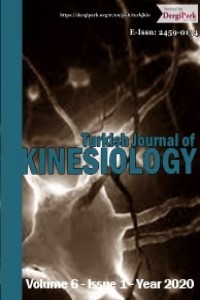The influence of active breaks in the long jump on sports performance
The influence of active breaks in the long jump on sports performance
active break long jump, performance,
___
- Ayala, F., Moreno-Perez, V., Vera-Garcia, F. J., Moya, M., Sanz-Rivas, D., & Fernandez-Fernandez, J. (2016). Acute and time-course effects of traditional and dynamic warm-up routines in young elite junior tennis players. PLoS One, 11(4), 1–14.
- Bailey, S. J., Vanhatalo, A., Wilkerson, D. P., Dimenna, F. J., & Jones, A. M. (2009). Optimising the “priming” effect: Influence of prior exercise intensity and recovery during on O2 uptake kinetics and severe-intensity exercise tolerance. J Appl Physiol, 107(6), 1743–1756.
- Bishop, D. (2003). Warm up: Potential mechanisms and the effects of passive warm up on exercise performance. Sports Med, 33(6), 439-454.
- Bishop, D., Bonetti, D., & Dawson, B. (2001). The effect of three different warm-up intensities on kayak ergometer performance. Med Sci Sports Exerc, 33(6), 1026–1032.
- Fradkin, A. J., Zazryn, T. R., & Smoliga, J. M. (2010). Effects of warming-up on physical performance: a systematic review with meta-analysis. J Strength Cond Res, 24(1), 140–148.
- Guting, B., Stewart, K., Lewis, S., & Kruper, J. (1976). Oxygen consumption in the first stages of strenuous work as a function of prior exercise. J Sports Med Phys Fitness, 16, 60–65.
- Hedrick, A. (1992). Exercise physiology: Physiological responses to warm-up. National Strength and Conditioning Association Journal, 14(5), 25-27.
- Jones, A. M., DiMenna, F., Lothain, F., Taylor, E., Garland, S. W., Hayes, P. R., & Thompson, K. G. (2008). ‘Priming’ exercise and O2 uptake kinetics during treadmill running. Respir Physiol Neurobiol, 161(2), 182–188.
- McGowan, C. J., Pyne, D. B., Thompson, K. G., & Rattray, B. (2015). Warm-up strategies for sport and exercise: mechanisms and applications. Sports Med, 45, 1523–1546.
- McMillian, D. J., Moore, J. H., Hatler, B. S., & Taylor, D. C. (2006). Dynamic vs. static-stretching warm up: The effect on power and agility performance. J Strength Cond Res, 20(3), 492–499.
- Neiva, H., Marques, M., Barbosa, T., Izquierdo, M., & Marinho, D. (2014). Warm-up and performance in competitive swimming. Sports Med, 44, 319–330.
- Neiva, H., Marques, M., Barbosa, T., Izquierdo, M., Viana, J., Teixeira, A., & Marinho, D. (2015). The effects of different warm-up volumes on the 100 m swimming performance: A randomized crossover study. J Strength Cond Res, 29(11), 3026–3036.
- Neiva, H. P., Marques, M. C., Fernandes, R. J., Viana, J. L., Barbosa, T. M., & Marinho, D. A. (2014). Does warm-up have a beneficial effect on 100-m freestyle? Int J Sports Physiol Perf, 9, 145–150.
- Safran, M. R., Seaber, A. V., & Garrett, W. E. (1989). Warm-up and muscular injury prevention-an update. Sports Med, 8, 239–249.
- Stewart, I., & Sleivert, G. (1998). The effect of warm-up intensity on range of motion and anaerobic performance. J Orthop Sports Phys Ther, 27(2), 154–161.
- Van den Tillaar, R., Vatten, T., & von Heimburg, E. (2017). Effects of short or long warm-up on intermediate running performance. J Strength Cond Res, 31(1), 37-44.
- Vetter, R. E. (2007). Effects of six warm-up protocols on sprint and jump performance. J Strength Cond Res, 21(3), 819.
- Weidner, H., & Dickwach, H. (2022, December 20). Characteristics of the long jump technique. Modern Athlete and Coach. Microsoft Word - Weidner Characteristics of the LJ Technique.doc (speedendurance.com)
- Zois, J., Bishop, D., & Aughey, R. (2015). High-intensity warm-ups: Effects during subsequent intermittent exercise. Int J Sports Physiol Perform, 10(4), 498–503.
- Zois, J., Bishop, D. J., Ball, K., & Aughey, R. J. (2011). High-intensity warm-ups elicit superior performance to a current soccer warm-up routine. J Sci Med Sport, 14(6), 522–528.
- Yayın Aralığı: 4
- Başlangıç: 2015
- Yayıncı: Nurtekin Erkmen
Ramazan BAYER, Hadi NOBARI, Özgür EKEN, Serdar BAYRAKDAROĞLU, Hürmüz KOÇ, Elena Mainer PARDOS, Fatma Hilal YAĞIN
Senem DEMİRDEL, Gülşah GÜL, Öznur GÜMÜŞ, Betül KUZ
The influence of active breaks in the long jump on sports performance
Calfa HORATİU, Liliana MİHAİLESCU
Muhammed Zahit KAHRAMAN, Sedat OKUT, Cengizhan SARI, Ömer Faruk BİLİCİ, Fatih BİLİCİ
Alına Ionela PREDESCU, Liliana MİHĂİLESCU
Acute effect of different blood flow restriction protocols on muscle damage
Evaluation of agility and acceleration levels in male and female futsal players
The study of relative age effects on weightlifting athletes in U15 and youth age groups
Effects of foot preference on postural control in soccer players
Investigation of nutrition knowledge levels of basketball coaches working in Karaman city center
